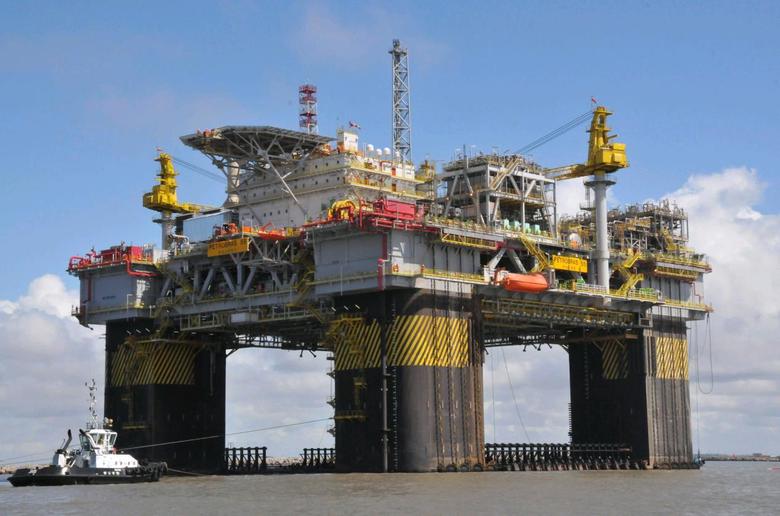
PETROBRAS: GOD IS BRAZILIAN

When Brazil's state-run oil company Petroleo Brasileiro SA disclosed its biggest-ever oil find, in 2007, then-president Luiz Inácio Lula da Silva quipped that the discovery proved that God is Brazilian.
New production figures are making believers out of many in the industry. Output from the "pre-salt" fields has passed 500,000 barrels of oil a day, nearly triple that of 2012, and now accounts for nearly a quarter of the company's total production of two million barrels a day.
It is a quick ramp-up for Petrobras, and is taking place in one of the most challenging oil patches in the world. The deposits lie nearly 200 miles off Brazil's southeastern coast, buried deep below the sea floor under a thick layer of salt, which gives the fields their name.
"In terms of productivity and the speed with which Petrobras has moved from zero barrels a day to 500,000 barrels a day, it's kind of unprecedented," says Ruaraidh Montgomery, an analyst at researcher Wood Mackenzie.
Production gains in pre-salt fields are sorely needed to offset declines in production at Petrobras' mature fields. Last year, Petrobras's total output fell to 1.93 million barrels of oil and equivalents a day, from 1.98 million in 2012. This year, as the pre-salt fields deliver more oil, overall output has inched up. In June production was 2.008 million barrels a day.
The Rio de Janeiro-based oil company is due to report its second-quarter results on Friday.
Riding the pre-salt boom, Brazil aims to be among the world's top five global oil producers by 2020, when it expects to be producing four million barrels of oil a day. But to hit that ambitious target, Petrobras will have to overcome financial as well as technical challenges.
The company's profit has been squeezed by Brazil's government, which forces it to sell imported gasoline at below cost to battle inflation. It also has borrowed heavily to finance exploration and development. Now the world's most indebted oil major, Petrobras projects it will have spent $102 billion in the pre-salt area by 2018; tens of billions more will be needed to fully develop those reserves.
Adding to the challenge is that Petrobras is pretty much on its own.
The Brazilian government's tough production-sharing rules require Petrobras to be the sole operator at all pre-salt projects and hold a minimum 30% stake. Those terms have turned off most major oil companies, which have opted to invest elsewhere. At the first and so far only auction for pre-salt fields, there was only one bid, a consortium led by Petrobras.
Brazil's pre-salt oil windfall is in some ways the opposite of the American shale oil boom. In the U.S., the door is open to all comers. Landowners settle for low royalties, but the result has been a massive increase in production and U.S. energy security in the process.
Still, there is no question that the pre-salt find has reshaped Brazil's energy industry. There are now more deep water oil rigs, supply vessels, and floating production and storage units operating in Brazil than anywhere else in the world, according to research firm IHS.
The two main basins are roughly the size of the state of Georgia and are estimated to hold 50 billion barrels of recoverable oil. The biggest field currently in production, named Lula after the former president's nickname, has an estimated eight billion barrels of oil alone—roughly eight times more than the biggest offshore field in the Gulf of Mexico.
To get at the oil there, Petrobras has invested billions of dollars on research, new 3-D imaging technology, a souped-up shipping fleet and bigger helicopters to get workers and equipment to the fields.
New drilling techniques also were needed to get to the fields, which can be as deep as 20,000 feet below the surface of the ocean. The salt layer alone—which is constantly shifting—can be as much as 6,500 feet thick.
Holes drilled in the salt can reseal themselves, so a special kind of mud must be used to keep them open. At those depths, the temperature swings from extreme heat to cold. The gas in the pre-salt fields is especially corrosive so special steel pipes are needed.
"To produce in these conditions, no one in the world had done this," said Edmundo Marques, chief exploration officer at Rio de Janeiro-based independent oil company Ouro Preto Óleo e Gás, and a former Petrobras executive.
Petrobras' next challenge lies in its existing, mature oil fields where production is falling fast. At the Roncador field, the country's biggest producer, output has dropped to 256,200 barrels a day, down from 395,000 barrels in 2010. That is putting pressure on Petrobras to keep up its winning streak in the pre-salt fields to meet production goals.
"It is a race, as the old giants are on the decline," says Bob Fryklund, an IHS strategist.
A company spokeswoman said the rate of decline at Petrobras' mature fields is below international benchmarks for such fields.
"Petrobras constantly works to offset the natural decline in production from its mature fields," the Petrobras spokeswoman said. "The company has been investing heavily in new projects and putting into operation a large number of production systems, in the pre-salt and post-salt [areas]."
wsj.com





